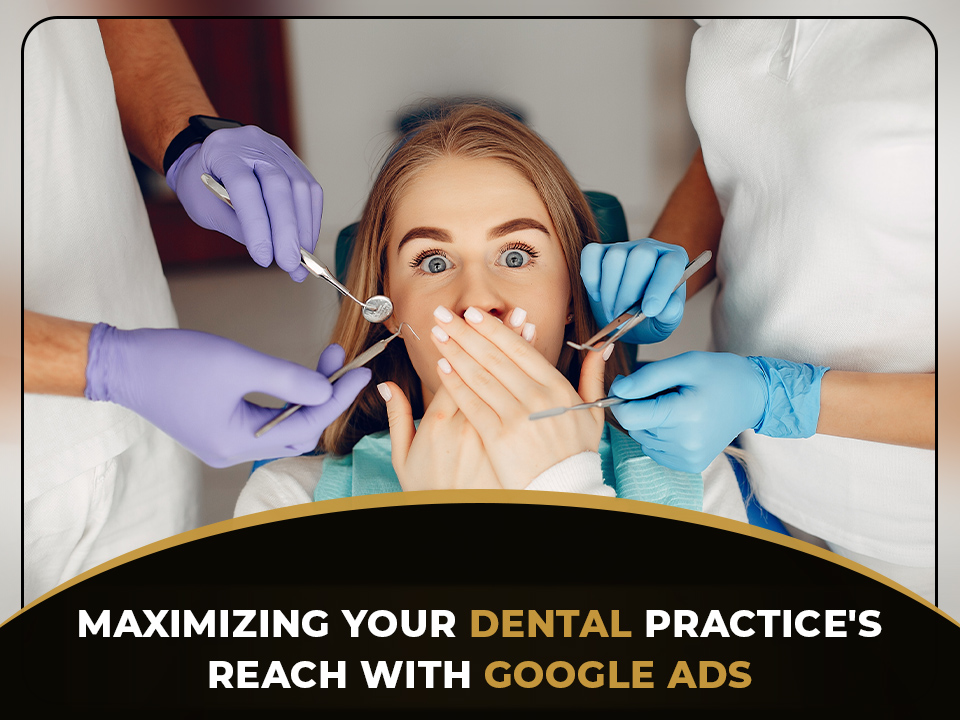
Maximizing Your Dental Practice’s Reach with Google Ads
As the world becomes increasingly digital, online advertising has become an essential tool for businesses of all types, including dental practices. Online advertising enables dental practices to reach a wider audience and promote their services to potential patients searching for dental services online. One of the most popular forms of online advertising is Google Ads, which provides a targeted approach to reach potential patients at the right time and place.
In this blog post, we will explore the benefits of using Google Ads for dental practices, including how it can help increase online visibility, improve website traffic, and attract new patients. We will also provide tips on creating effective Google Ads campaigns for dental practices and share some best practices to maximize your advertising efforts’ return on investment (ROI). Whether new to online advertising or looking to optimize your existing campaigns, this post will provide valuable insights and guidance to help you grow your dental practice through effective online advertising.
Understanding the basics of Google Ads
Google Ads, formerly Google AdWords, is an online advertising platform developed by Google. It allows businesses to create and display ads to potential customers on Google’s search engine results pages (SERPs) and partner websites. The platform operates on a pay-per-click (PPC) model, meaning businesses only pay when someone clicks on their ad.
Google Ads offers a variety of ad formats and placements to choose from, including:
- Search ads: These are the most common type of Google Ads and appear at the top and bottom of the search engine results pages (SERPs) when someone searches for a specific keyword or phrase related to your dental practice.
- Display ads: These ads appear on websites that are part of Google’s Display Network, which includes millions of sites across the internet. They can be in the form of banners, images, or videos.
- Video ads: These are ads that appear on YouTube videos and can be in-stream (before, during, or after a video), video discovery (on the YouTube homepage, search results pages, and related videos), or bumper (short ads that appear before a video).
- Shopping ads: These ads display product images and prices on the Google Shopping tab when someone searches for a specific product or service.
To set up a Google Ads account and campaign, you must create an account with your email address and website URL. You’ll then need to set up a campaign, which involves selecting your ad format, targeting options (such as location, demographics, and interests), and setting a budget and bid amount for your ads. You can also create ad groups within your campaign to organize your ads by theme or topic. Once your campaign is set up, your ads will start running, and you can monitor their performance and make adjustments as needed.
Crafting compelling ad copy and landing pages
Crafting compelling ad copy and landing pages is essential for a successful Google Ads campaign. Here are some best practices and tips to help you create compelling ad copy and landing pages:
1. Ad Copy
- Use attention-grabbing headlines: Make sure your headline stands out and captures the user’s attention. Use keywords and phrases that appeal to your target audience and highlight the benefits of your services.
- Highlight unique selling points: Differentiate yourself from competitors by highlighting your unique selling points. These could include special offers, unique services, or expert qualifications.
- Include a call-to-action (CTA): Your ad copy should include a clear and concise CTA that encourages users to take action. Use action-oriented language and specific verbs such as “Book now” or “Schedule your appointment today.“
2. Landing Pages
- Keep it simple: Your landing page should be simple and easy to navigate. Avoid cluttered designs and long blocks of text.
- Focus on user experience: Ensure your landing page provides a seamless experience. Make it easy for users to find what they’re looking for and include clear and visible CTAs.
- Highlight benefits: Similar to your ad copy, your landing page should highlight the benefits of your services and differentiate yourself from competitors.
- Use high-quality visuals: Use high-quality images and videos to showcase your services and create an engaging user experience.
Examples of compelling ad copy and landing pages
1. Ad Copy
- “Transform Your Smile with Our Teeth Whitening Services – Book Your Appointment Today!”
- “Expert Dental Care for Your Family – Schedule Your Appointment with Our Trusted Team”
- “Get the Perfect Smile You’ve Always Wanted – Our Orthodontic Services Can Help!”
2. Landing Pages
- A landing page for a teeth whitening service with a clean and simple design, high-quality images, and a prominent CTA button that directs users to book an appointment.
- A landing page for a family dental practice features images of happy families, a clear list of services, and a prominent CTA button that encourages users to schedule an appointment.
- A landing page for an orthodontic practice showcasing before-and-after images of successful treatments highlights the orthodontist’s qualifications. It includes a clear CTA button that directs users to book a consultation.
Read More: How Dentists Can Generate More Leads and Grow Their Practice?
Optimizing your Google Ads campaign for maximum ROI

Once your Google Ads campaign is up and running, optimizing it to improve your ROI continuously is important. Here are some strategies and best practices for optimizing your Google Ads campaign:
1. Improve Click-Through Rates (CTR) and Quality Scores
- Use relevant and specific keywords in your ads.
- Include attention-grabbing headlines and descriptions.
- Use ad extensions to provide additional information and increase CTR.
- Optimise landing pages to improve user experience and relevance.
Improving your CTR and Quality Scores can help you achieve a higher ad rank, resulting in more visibility and potentially lower costs-per-click (CPC).
2. Use Bidding Strategies to Optimize Your Budget
- Set a maximum CPC bid to avoid overspending.
- Use automated bidding strategies to adjust bids in real time based on performance.
- Use target CPA or target ROAS bidding strategies to optimize for specific goals.
Bidding strategies can help you maximize your budget and achieve your desired results while minimizing costs.
3. Best Practices for Ad Scheduling and Targeting
- Use ad scheduling to show ads during the times of day or days of the week when your target audience is most active.
- Use geotargeting to show ads to users in specific locations.
- Exclude irrelevant locations or demographics to avoid wasting ad spend.
- Use audience targeting to show ads to users who have previously interacted with your website or similar websites.
Ad scheduling and targeting can help you reach the right audience at the right time, improving the likelihood of conversions and maximizing ROI.
You can improve performance and achieve maximum ROI by continuously optimizing your Google Ads campaign. Keep track of critical metrics, such as click-through rates, conversion rates, and cost-per-acquisition, and adjust your campaign accordingly to achieve your desired results.
Tracking and measuring success through analytics
Tracking and measuring success through analytics is critical to running a successful Google Ads campaign. Here are some tips and best practices for tracking and measuring success through analytics:
1. Google Ads Analytics and Reporting
- Use Google Ads reporting to monitor key metrics such as impressions, clicks, CTR, conversion rates, and cost-per-conversion.
- Use Google Analytics to gain deeper insights into user behaviour on your website, including bounce rates, time on site, and conversion paths.
2. Tracking Conversions and Measuring ROI
- Use conversion tracking to measure how many users complete a desired action, such as purchasing or filling out a contact form.
- Use conversion values to assign a value to each conversion and measure ROI.
- Use attribution models to measure the impact of different touchpoints on the conversion path.
3. Using Data to Optimize Your Campaign
- Use A/B testing to test different ad copy, landing pages, and bidding strategies.
- Use data to identify underperforming keywords, locations, and demographics and adjust your campaign accordingly.
- Continuously monitor and adjust your campaign based on data to improve performance and ROI.
You can gain valuable insights into user behaviour and campaign performance by tracking and measuring success through analytics. Use this data to optimize your campaign and achieve maximum ROI continuously.
Read More: 5 STEPS TO AN EFFECTIVE SOCIAL MEDIA STRATEGY FOR YOUR SMALL BUSINESS
Tips for ongoing campaign maintenance and improvement

Running successful Google Ads campaigns requires constant attention and ongoing optimization. Here are some tips for maintaining and improving your campaigns over time:
- Regularly review and analyze campaign performance data: Track your campaign’s metrics such as click-through rate (CTR), conversion rate, cost per conversion, and return on ad spend (ROAS). Analyzing this data can help you identify areas that need improvement and adjust your campaign strategy accordingly.
- Test and optimize ad variations: Experiment with different ad formats, headlines, descriptions, and calls to action to see what works best for your target audience. Use A/B testing to compare different ad variations and measure their effectiveness.
- Use negative keywords: Negative keywords help avoid showing your ads for irrelevant searches. Review your search terms report regularly and add negative keywords to prevent wasted ad spend.
- Keep an eye on your competition: Monitor your competitors’ ad campaigns and adjust your strategy accordingly. Pay attention to their ad copy, landing pages, and bidding strategy.
- Utilise ad extensions: Ad extensions provide additional information to potential customers, such as phone numbers, reviews, and links to specific pages on your website. Use ad extensions to make your ads more informative and engaging.
- Stay up-to-date with Google Ads changes and updates: Google regularly introduces new features and updates to its advertising platform. Stay informed about these changes and adapt your campaigns to seize new opportunities.
- Monitor your budget and bidding strategy: Keep track of your ad spend and adjust your bidding strategy based on campaign performance. Use bid modifiers to adjust bids for specific locations, devices, and times of the day.
By following these tips, you can continuously improve your Google Ads campaigns and achieve better results.
Conclusion
In conclusion, Google Ads is a powerful tool that can help drive more traffic and leads to your dental practice’s website. Creating targeted campaigns and continuously optimizing them can attract high-quality leads and grow your business.
We encourage you to take action and optimize your Google Ads campaigns today. Good luck!


